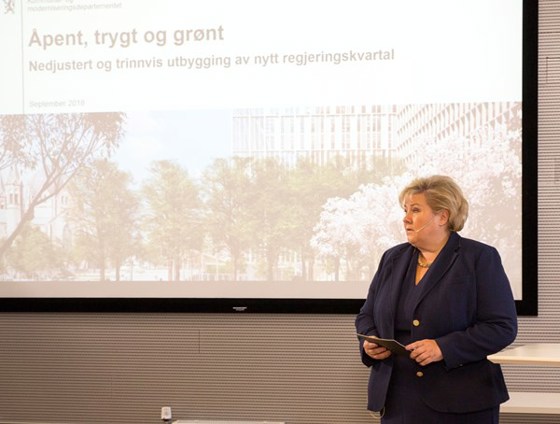An open, safe and green Government Building Complex
Historical archive
Published under: Solberg's Government
Publisher: Ministry of Local Government and Modernisation
Press release | Date: 28/09/2018 | Last updated: 11/12/2018
Norway's new Government Building Complex will be slightly smaller than previously estimated. It will be climate and environmentally friendly, and it will be developed in several stages. “We will build an open, safe and green Government Building Complex that will be good for the city and good for those who will be working there," says Prime Minister Erna Solberg.

Today the Government is presenting a sketch project for the new Government Building Complex. It will provide a higher level of security than at present, but the area will still be more open and accessible to pedestrians and cyclists. It will blend in with the city structure, contribute to city life and be attractive to both the general public and employees.
“It will be a vibrant, enjoyable and car-free area. The new Government Building Complex will be a part of the capital that people will enjoy visiting, whether they live in Oslo or are visiting,” says the Prime Minister.
- Government Building Complex: new illustrations
Lower buildings
In the new sketch, the new buildings will be lower than allowed by the zoning plan. The total volume will also be less than previously planned. It has been established that all the ministries, except the Ministry of Defence, will be united in the new complex. However, the plans are now for 4700 employees, significantly fewer than the 5700 in the original plans.
"After many years of growth in the number of employees in the ministries, we see that our policy of simplification and reduction of bureaucratisation has worked. We simply do not need the same number of workplaces in the future. We will also be placing some support functions outside the complex, so that we can reduce the volume of the new buildings,” says Minister of Finance Siv Jensen.
The Government is preparing for incremental and efficient development.
“To reduce the construction costs, it is a prerequisite that the development take place efficiently. This entails that it will be three years from putting the first spade in the ground until the first people move in. The new plans will give us a functional and efficient Government Building Complex, with 30 per cent less floorspace than today. It will give us a more compact Government Building Complex, and we will be saving large amounts of the taxpayers’ money,” says Jensen.
The step-by-step construction provides the flexibility to adapt the buildings to the actual change in the number of employees.
High-Rise Block will be first
The intention is to rehabilitate the High-Rise Block first. The Office of the Prime Minister and the Ministry of Justice and Public Security will then be among the first to move back into the Government Building Complex since the terrorist attack on 22 July 2011. At the same time, Building D will be built between the High-Rise Block and Møllergata 19, and the Ministry of Foreign Affairs will move in here. With the start of construction in 2020, the High-Rise Block, D Building and Møllergata 19 will be ready for occupancy in early in 2024.
An important building in Stage 1 will be the A building, which, together with the High-Rise Block and the Ministry of Finance (Block G) will frame Johan Nygaardsvold’s Square. The Square will be more open, while the three buildings will also exhibit a historical line in the development of the Government Building Complex from 1906 until the 2020s. Construction Stage 1 will also consist of the basement, protective measures for Ring 1 and area protection.
“In the future, we will focus on finding the best possible solutions for the urban environment. It is important to find good solutions for public transport in and around the new Government Building Complex,” says the Minister of Local Government and Modernisation Monica Mæland.
The new Government Building Complex should have good workplaces and create a framework for a good and flexible working environment for the government apparatus. Emphasis is placed on providing space for various workplace solutions, so that the ministries can choose among different solutions.
“We maintain that the floorspace per employee should be 23 square meters. This is less than in the current premises, but more than what many businesses allow when they build new office space. An increase is unfortunate for costs, the climate and the urban environment,” Mæland maintains.
The environment will an important part of this major construction project, and the new Government Building Complex will have future-oriented environment buildings.
“We will use the BREEAM environmental classification system. One must then be conscious of the environment in all phases of the construction project. It looks like we will be aiming at the “Excellent” level, says the Minister of Climate and Environment Ola Elvestuen.
Modern technology will also be implemented: “The buildings will be cooled and heated by sea water. Overall, this means less energy consumption and more climate-friendly buildings,” says Elvestuen.